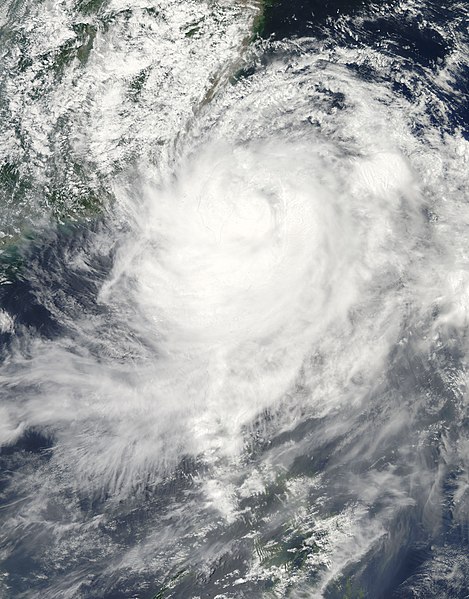Torrential rains from the storm killed at least 65 people in Taiwan, with over 600 more missing, many of whom are feared dead after a massive mudslide buried the entire 1,300-resident village of Xiaolin. An additional 23 people were killed in the Philippines and six more in China. Damages from the storm amounted to at least $1.4 billion in China and more than $209 million in Taiwan. At least 10,000 others were missing in mountainous areas cutoff from the rest of the country, hundreds of whom are feared dead.
Early on August 2, 2009, the Japan Meteorological Agency (JMA) reported that the season's eleventh tropical depression had formed within a monsoon trough located about 1000 km (620 mi), to the east of the Philippines. However the depression remained weak, and was downgraded to an area of low pressure before regenerating later that day. Both the Joint Typhoon Warning Center (JTWC) and the Philippine Atmospheric, Geophysical and Astronomical Services Administration (PAGASA) then started to monitor the depression early the next day whilst it was located about 700 km (430 mi) to the southeast of Okinawa, Japan with PAGASA assigning the name Kiko to the depression. The JTWC were reporting at this time that it was an area of convection with deep convection flaring on the western side of a partially exposed low level circulation center at this time.
Later on August 3, the JMA reported that the depression had intensified into a Tropical Storm and named it as Morakot. The JTWC further designated it as Tropical Depression 09W as deep convection had increased over the low level circulation center and reported that it was moving around a low level ridge of pressure which was located to the east of the low level circulation center. On the morning of August 4, the JTWC reported that the Morakot had steadily intensified into a Tropical storm as wind-speeds were estimated to be near 65 km/h (40 mph) with deep convective banding building towards the low level circulation center under the influence of a subtropical ridge located to the east of the system. Later that day the JMA reported that Morakot had intensified into a Severe Tropical Storm.
In the Philippines, eleven villages (Paudpod, San Juan, Baton-lapoc, Carael, Tampo, Paco, San Miguel, Binig, Bangan, and Capayawan) have been submerged in 4-foot to 5-foot deep floods after the Pinatubo Dike overflowed. Joint military and police rescue teams rescued 3 Koreans and 9 Canadian nationals. About 30,000 families were affected by Morakot; eleven people are confirmed dead. Three French tourists and two Filipino guides were killed in a flashflood caused by a landslide. Thousands are trapped on rooftops or in trees awaiting helicopter rescue attempts and thousands have lost their homes. At least two have died from flooding. Landslides have claimed the lives of no less than twelve miners while others are still missing after a mine caved in. Schools have suspended their classes in the hardest hit area, and highways have been closed due to landslides.
In Taiwan, where schools were closed ahead of the typhoon, Morakot caused landslides, severe floods, blew down trees and billboards, and stripped roofs from buildings. In a positive impact, Morakot brought much-needed rain to Taiwan, ending a month-long drought, and replenished reservoirs enough to warrant an end to water rationing. However, on the island, 18 people were killed, 35 were injured and 131 are missing. Almost the entire southern region of Taiwan (Chiayi, Tainan, Kaohsiung, and Pingtung counties) and parts of Taitung County were flooded by record-breaking heavy rain. The rainfall in Pingtung County exceeded 2,500 millimetres (98 in), breaking all rainfall records of any single place in Taiwan induced by a single typhoon. Airlines in Taiwan have held some flights in and out of the airport, and seaports are closed. Electricity has been lost to approximately 25,000 homes.
Reports indicated that at least 600 people were missing throughout southern Taiwan. Most of the people were residents of Shiao-Lin Village (小林), a 1300 residents mountain village in Jiaxian, Kaohsiung. The village is buried by a massive mudslide that destroyed most of the town. It is reported that all roads toward Namaxia, Kaohsiung have been either blocked or washed away by severe mudslides. Hundreds of residents have been trapped for four days, and are running out of food and water. In addition, water and electricity have all been cut. A rescue helicopter, working to retrieve survivors of the mudslide crashed into a mountain side early on August 11, killing the three occupants. Crews have been unable to reach the wreckage due to the steep terrain of the mountain.
A swollen river in Taitung County undermined 51 homes and swept them away into the Pacific, leaving numerous residents homeless. No one was in the homes when they fell into the river. The six-story Jinshuai Hotel was destroyed by flood waters after being undermined and collapsing into the Jhihben River. Several stores in front of the hotel were washed away days earlier as the river continued to overflow its banks and inundate nearby towns and cities. Running water in Tainan County to 280,000 was shut down as flood waters contaminated the local reservoir.
Throughout Taiwan, at least 62 people were confirmed to have been killed by the storm. The record-breaking rains also caused catastrophic agricultural losses, with preliminary estimates reaching NT$6.9 billion ($209 million USD). At its peak, roughly 1.58 million were without power across the island and over 710,000 were without water pressure. Tourism losses due to the typhoon were estimated to be at least NT$800 million ($24.4 million USD).